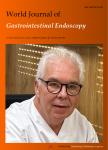Pathological evaluation of gastrointestinal endoscopic submucosal dissection materials based on Japanese guidelines
作者机构:Department of Pathology Saitama Medical University International Medical Center
出 版 物:《World Journal of Gastrointestinal Endoscopy》 (世界胃肠内镜杂志(英文版)(电子版))
年 卷 期:2012年第4卷第11期
页 面:489-499页
学科分类:1002[医学-临床医学] 100214[医学-肿瘤学] 10[医学]
主 题:Esophagus Stomach Colon Rectum Biopsy Endoscopic mucosal dissection Surgical pathology Diagnosis Guideline Immunohistochemistry
摘 要:Endoscopic surgery first started as snare polypectomy and then progressed to endoscopic mucosal resection (EMR). In order to resect a lesion that is more than 2 cm, endoscopic submucosal dissection (ESD) was developed. ESD therapy has now been established and is being used for early stage neoplastic lesions in the stomach, colon, esophagus, larynx and pharynx. In ESD specimens, we deal with relatively small lesions; therefore, more meticulous and precise pathological diagnosis is required compared to that in surgically resected specimens. In addition, we should be expert in the eligibility criteria of the different organs for ESD therapy. Here, we explain the biopsy diagnosis, including the Japanese group classification as well as the Vienna classification, handling the specimen, including fixation, photography, cutting and paraffin embedding, histological type, depth, vascular invasion and evaluation of the surgical margins, based on the latest Japanese guidelines. Japanese histopathology diagnostic criteria for the stomach, colon and esophagus are also described. We also demonstrate some examples of those mentioned above.



